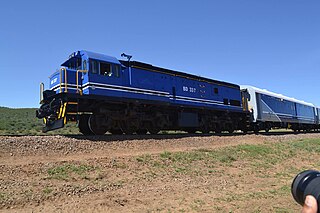
Transportation in Botswana is provided by an extensive network of railways, highways, ferry services and air routes that criss-cross the country. The transport sector in Botswana played an important role in economic growth following its independence in 1966. The country discovered natural resources which allowed it to finance the development of infrastructure, and policy ensured that the transport sector grew at an affordable pace commensurate with demands for services.

Gaborone is the capital and largest city of Botswana with a population of 246,325 based on the 2022 census, about 10% of the total population of Botswana. Its agglomeration is home to 421,907 inhabitants at the 2011 census. Gaborone has per capita income of US$32,000 (PPP), the highest in Africa.

Palapye is a growing town in Botswana, situated about halfway between Francistown and Gaborone. Over the years its position has made it a convenient stopover on one of Southern Africa's principal north–south rail and road routes.
Air Botswana Corporation is Botswana's state-owned national flag carrier, with its headquarters located in Gaborone. It operates scheduled domestic and regional flights from its main base at Sir Seretse Khama International Airport. Air Botswana has been loss-making for several years, and there have been various attempts to privatise the company, and frequent changes to the corporation's management and board, so far without reducing the losses.

Botswana Railways (BR) is the national railway of Botswana.

Rail services in Botswana are provided by Botswana Railways in Botswana. Most routes in the country radiate from Gaborone. The railway network consists of 888 km, its gauge is 1,067 mm cape gauge.

Maun Airport is an international airport serving the town of Maun in the North-West District of Botswana. It is on the north side of the town and is accessible by shuttle bus or taxi.
List of Railway stations in Botswana include:
Yarona FM is an urban broadcaster targeting young adults. The radio station is a private commercial entity that has existed since 1999. It is regulated by BOCRA and attracts a unique weekly audience of 250,000.
Vehicle registration plates of Botswana for normal motor vehicles begin with the letter B, followed by three digits, followed by three letters. The digits and letters are assigned by a registrar. The three letters will never include the letter Q so as to avoid confusion with the letter O. The front number plates have black lettering on a white reflective background. The rear number plates have black lettering on a yellow reflective background. Public passenger number plates have white lettering on blue background at both the front and rear.

Botswana has produced postage stamps for national use since becoming independent on 30 September 1966. The country formerly used the stamps of the Bechuanaland Protectorate. The first independence issue of 1966 included depictions of an abattoir in Lobatse, Botswana National Airways and the State House in Gaborone.
Botswana National Airways was an airline based in Gaborone, Botswana.

First Capital Bank Botswana Limited, formerly known as Capital Bank, is a commercial bank in Botswana, licensed by the Bank of Botswana, the central bank and national banking regulator. It is a subsidiary of FMBCapital Holdings Plc, a Mauritius-based financial services conglomerate, whose shares of stock are listed on the Malawi Stock Exchange and has subsidiaries in Botswana, Malawi, Mozambique, Zambia and Zimbabwe.
The history of Gaborone began with archaeological evidence in the area around Gaborone dating back to 400 BCE, and the first written accounts of Gaborone are from the earliest European settlers in the 19th century. Since the 1960s, when Botswana gained its independence from Britain and Gaborone became the capital, the city has grown from a small village in the Botswana scrubland to a major center in southern Africa.
The Church of Jesus Christ of Latter-day Saints in Botswana refers to the Church of Jesus Christ of Latter-day Saints and its members in Botswana. The first branch was organized in 1991 with fewer than 100 members. As of 2022, there were 4,031 members in 16 congregations in Botswana.
The Botswana Prison Service (BPS) is the corrections agency of Botswana. It holds pre-trial and convicted prisoners.

Radio Botswana- abbr RB1 is a radio station in Botswana operated by the Government of Botswana in the capital city Gaborone. The Radio station provides news, current affairs about the country Botswana, the culture of Botswana, education and also provides entertainment to its followers. Radio Botswana station 1 started diffusing to its crowd in the year 1965 and during that time it was initially called the Radio Bechuanaland before the country became independent. During the time it was called Radio Bechuanaland, the station got assistance of wave transmition from the Mafikeng Veterinary, and it served the department with communication covering a circle of 20 miles. The partnership between the Mafikeng veterinary and radio Bechuanaland was to broadcast the agricultural agenda/programmes.
Radio Bechuanaland from the year 1967 was on air at a band of 90 meters every night. The station is called Seroma mowa sa Botswana in Setswana language.
The History of Botswana includes its pre-state history, its colonial period as the Bechuanaland Protectorate, and its modern history as a sovereign state.









